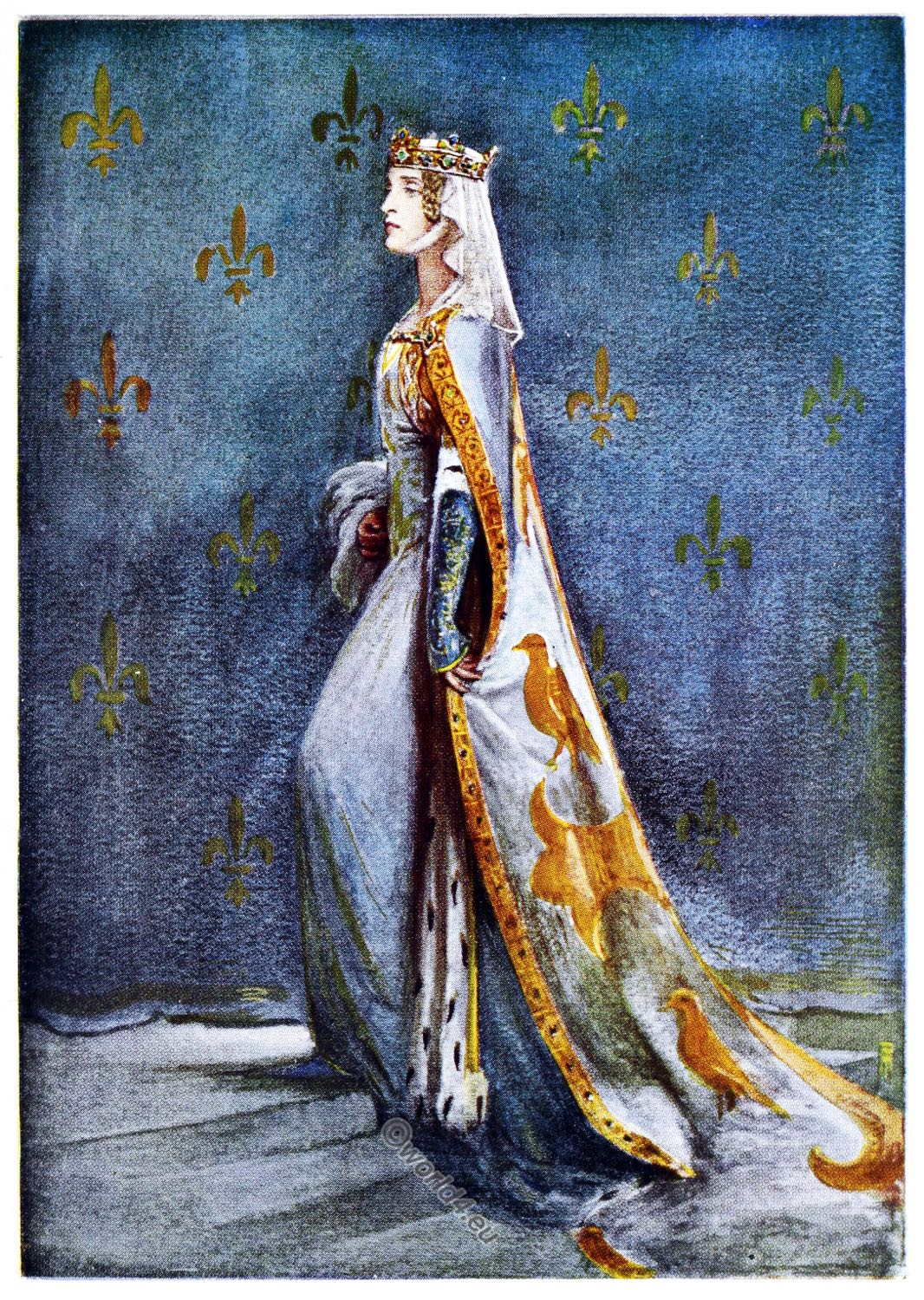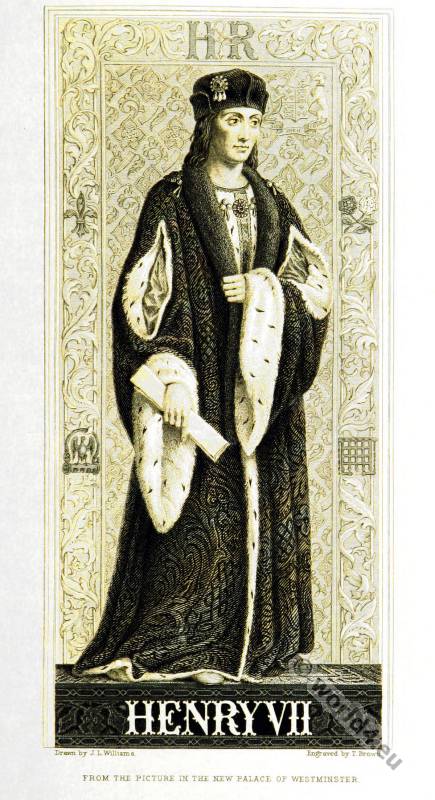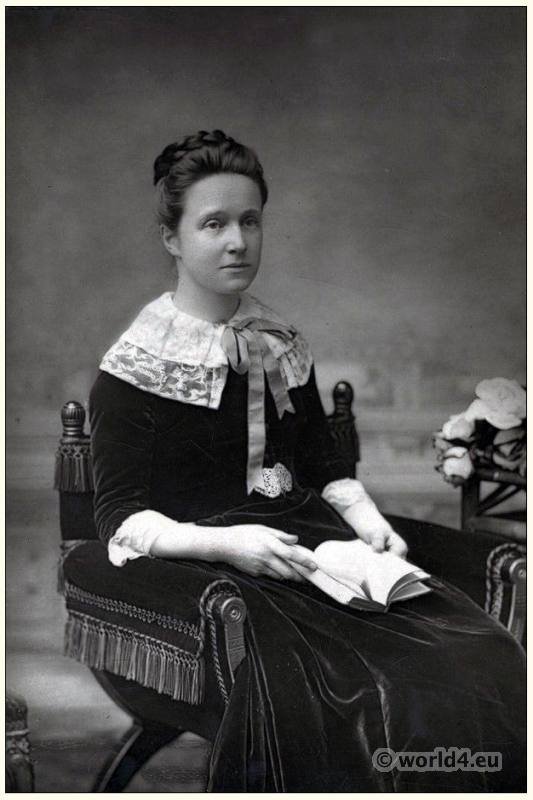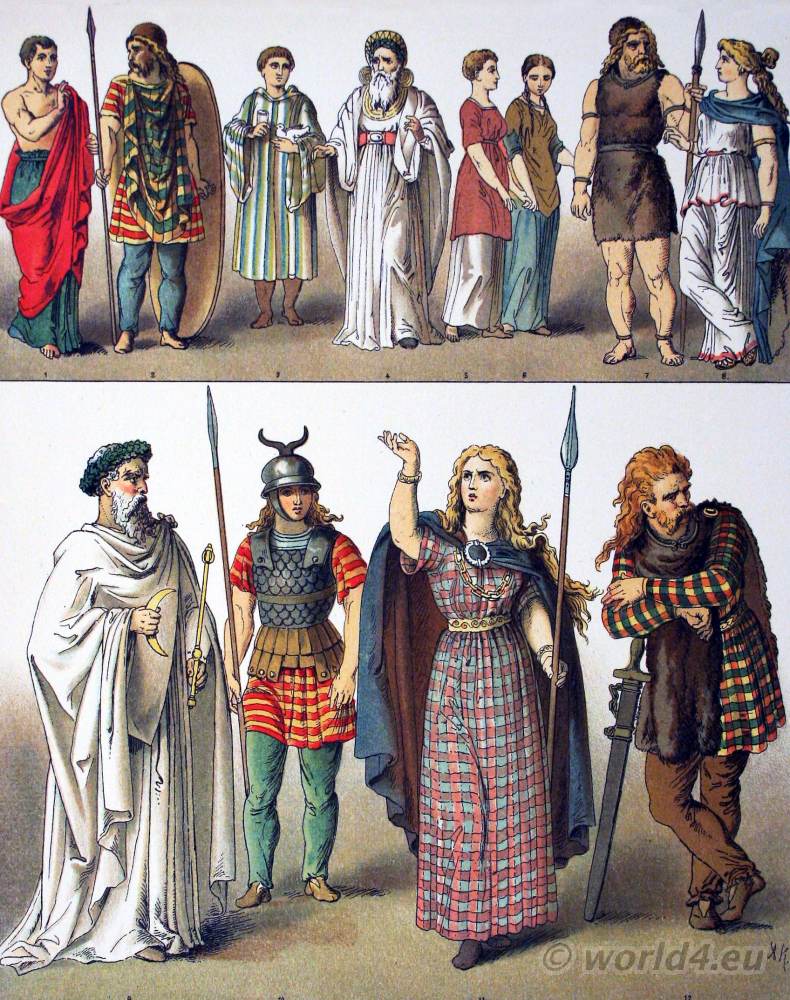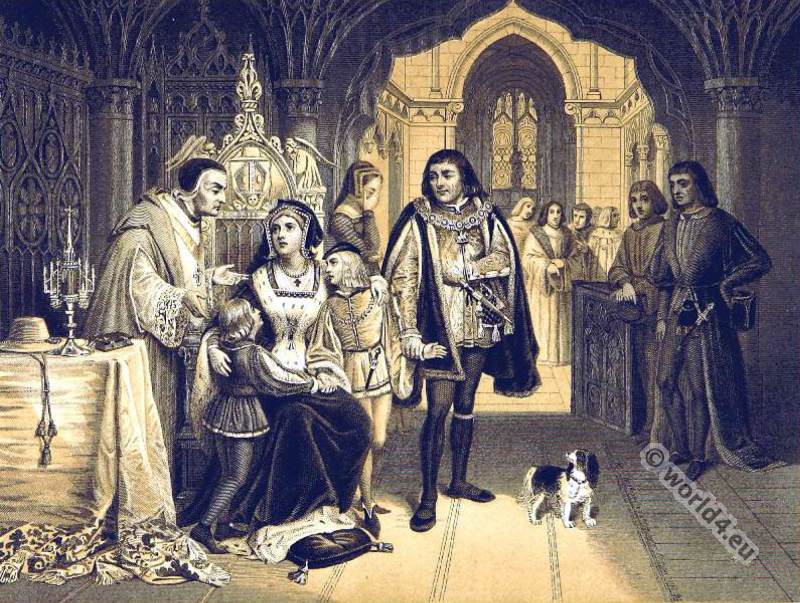
The sons of Edward IV parted from their mother, by Richard Duke of Gloucester, June 16th 1483. Engraved by W. Ridgway from the painting by N. Gosse of Paris.
King Richard III (1452-1485) and the young princess.
Richard III was from 1483 until his death at the Battle of Bosworth King of England. He was the last British monarch of the House of Plantagenet and also the last, who died on a battlefield. With his death ended the era of the so-called Wars of the Roses, in the two secondary lines of the Plantagenets. In 1597 Shakespeare wrote the drama The Tragedy of King Richard III., Which has partially influenced Richards image until today. With a targeted excavation in Leicester in September 2012 remains were found which unequivocally in February 2013 as the Richards III. could be identified.
During the hundred and sixty years which preceded the Union of the Roses, nine kings reigned in England. Six of these nine kings were deposed. Five lost their lives as well as their crowns. It is evident therefore that any comparison between our ancient and our modern polity must lead to most erroneous conclusions, unless large allowance be made for the effect of that restraint which resistance and the fear of resistance constantly imposed on the Plantagenets.
As our ancestors had against tyranny a most important security which we want, they might safely dispense with some securities to which we justly attach the highest importance. A nation of hardy archers and spearmen might, with small risk to its liberties, connive at some illegal acts on the part of a prince whose general administration was good, and whose throne was not defended by a single company of regular soldiers. If a popular chief raised his standard in a popular cause an irregular army could be assembled in a day.
Regular army there was none.
Every man had a slight tincture of soldiership, and scarcely any man more than a slight tincture. The national wealth consisted chiefly in flocks and herds, in the harvest of the year, and in the simple buildings inhabited by the people. All the furniture, the stock of shops, the machinery which could be found in the realm, was of less value than the property which some single parishes now contain. Manufactures were rude, credit was almost unknown. Society therefore recovered from the shock as soon as the actual conflict was over. The calamities of civil war were confined to the slaughter on the field of battle, and to a few subsequent executions and confiscations. In a week the peasant was driving his team and the esquire flying his hawks over the field of Towton or of Bosworth, as if no extraordinary event had interrupted the regular course of human life.
Though during the feeble reign of Henry VI. the state was torn first by factions, and at length by civil war; though Edward IV. was a prince of dissolute and imperious character; though Richard III. has generally been represented as a monster of depravity; though the exactions of Henry VII. caused great repining, it is certain that our ancestors, under those kings, were far better governed than the Belgians under Philip, surnamed the Good, or the French under that Louis who was styled the father of his people. Even while the wars of the Roses were actually raging, our country appears to have been in a happier condition than the neighbouring realms during years of profound peace (Macaulay).
No small part of this condition must be attributed to the increased political influence which had been acquired by the commons, not only in parliament, where by the constitution they had always (in theory at least) had a voice, but because of the growth of intelligence and the expansion of commerce, which gave to the burgesses of our larger towns, and especially to the citizens of London, an importance which was of considerable weight during a changeful period. When rival claimants contested the throne it became necessary not only to secure the allegiance of the great nobles but to conciliate the people, and when the Duke of Gloucester had laid the profoundly treacherous plan by which he was able to seize the crown, he based his pretensions not only on the assertion of the illegitimacy of his brother’s children, but on the assumed suffrages of the citizens of London.
There can be little doubt that Richard, Duke of Gloucester, was one of the most cultivated intellects of his time, and that though he ruthlessly disregarded many primary moral claims he was favorable to education and to a liberty which, while it left him master of the realm, should defy the power of the nobles, whose claims had too long deferred the true freedom of the people. It is not a very uncommon thing to discover that an autocrat may be theoretically the head of a republic, where individual liberty is supposed to be the chief end of the oppression which is exercised by the ruler himself. We have most of us heard of that kind of arbitrary rule which is declared to be only the necessary method for educating a people up to a point when independence will be possible for them.
Richard would doubtless have expressed this view, and perhaps not altogether insincerely. The first and only act of parliament passed in his reign was also the first that was in English, and he theoretically abolished those “benevolences” or enforced loans which had been so bitterly resented by the citizens in the reign of Edward. Their proscription was in theory only, however, for towards the end of his reign, amidst the added execrations of the people, similar grants were forcibly demanded, the only difference being that they were not to be called “benevolences”— upon which the citizens named them “malevolences.”
It has been granted that Richard, when he was Duke of Gloucester, was a patron and even a promoter of learning, and amidst some obscurity which rests upon his early history, it may be assumed that he was himself a scholar. Subsequent events show him either to have been deficient in moral sense, or to have made all his actions subservient to a bad and unscrupulous ambition which permitted nothing to stand in the way of his attaining the crown. Some of those with whom he had to contend were themselves so little moved by moral considerations, that he thought it necessary, in order to achieve his ends, to be even less amenable to the demands of conscience. The Woodvilles were not only parvenus, with little claim save that of the favouritism of Edward IV., but they appear to have been so base and designing as to have disregarded even the commoner sentiments of honour.
On the death of Edward they held nearly all the chief commands, and the two young princes were in the hands of the queen’s relations, from whose grasping ambition much was to be feared, while the Howards, the Stanleys, and other heads of ancient houses were bitterly opposed to them, in spite of the peace which the king had endeavoured to patch up between the rival factions. Richard was then at the head of a considerable army in the marches of Scotland, the Prince of Wales was at Ludlow Castle with his maternal uncle, the Earl of Rivers, his younger brother, was with his mother in London.
When the Duke of Gloucester started to York with a retinue of 600 knights and esquires, all like himself clad in mourning suits, the strife in the council had begun. Hastings had threatened the queen; Buckingham was almost in open rebellion. Richard, who with his followers had sworn fealty to his nephew at York, increased the number of his men-at-arms as he came southward; the queen-mother began to suspect, and Elizabeth to fear him. Lord Rivers was charged to bring the prince to London with an escort of 200 armed horsemen, and the queen attempted, against the advice of the council, to collect another army there. Both doubts and fears were justified, but Richard the arch dissembler made the imprudence of his opponents a reason for carrying out his designs. He arrived at Northampton on the very day that his nephew was carried to Stony Stratford, only ten miles distant. Earl Rivers and Lord Gray went on behalf of the prince to greet the Duke of Gloucester. Buckingham arrived at the same time with a troop of 300 horse. The two dukes, the earl, and the lord supped together, and passed a convivial evening.
The next day Gloucester and Buckingham continued the journey to Stony Stratford in company with their guests, who were, however, arrested the moment they entered the town. They were accused by Richard of estranging the affections of his nephew, and were at once secured, after which Richard and Buckingham waited on the prince, bent their knees before him, and saluted him as king. They next ordered the arrest of his two adherents, Sir Thomas Vaughan and Sir Richard Hawse, commanding the rest of his attendants to disperse, and making him in reality a prisoner under pretence of escorting him themselves.
The noblemen who had been arrested were consigned to Pontefract Castle, and though Hastings assured the people of London that the two dukes were acting for the good of the realm, the queen was so alarmed that she took the Duke of York to Westminster, there to claim the right of sanctuary. Thither Rotherham, Archbishop of York and chancellor to the queen-mother, went to console her, but she was already foreboding evil, and the assurances sent by Hastings, who seems to have been partially duped by Richard, did not suffice to abate her anxiety. Hastings was more successful in the city, and the Londoners were persuaded that the queen’s relations were concerned in a plot to destroy the Dukes of Gloucester and Buckingham, a declaration which was supported by the exhibition to the populace of barrels filled with arms said to have been intended for the purpose. The arrival of the two dukes bringing the young king was eagerly expected as the means of restoring tranquillity, and the chief citizens, with gowns and chains, rode out to meet the royal party as far as Hornsey Wood. Then all the party entered London, Gloucester riding bareheaded before his nephew, who was dressed in royal robes.
The queen’s fears were soon verified. Her son, who was at first lodged in the palace of the bishop, had little opportunity of seeing her in the sanctuary of Westminster. The council was summoned, and at the instance of Buckingham agreed to send the boy to the Tower for safety before the coronation, which was fixed for the 22d June; and on the 16th of June Richard (who was then “protector”), with the Cardinal Archbishop of Canterbury and several other prelates and lords, proceeded to Westminster to demand that the Duke of York should join his brother, as his presence would be necessary at the coronation, while his remaining in sanctuary was causing dishonourable rumours and suspicions. Elizabeth yielded—probably from the conviction that resistance would be useless. Only three days had passed since that scene was enacted in the council chamber at the Tower, which has been so vividly represented by Shakespere. It had ended in the immediate execution of Hastings, and the imprisonment of Lord Stanley, the Archbishop of York, and the Bishop of Ely, while at the same time Earl Rivers, Lord Gray, Sir Thomas Vaughan, and Sir Richard Hawse were beheaded at Pontefract.
In the pages of the great dramatist as in the pages of history we read how through blood and by treachery Richard crept to the throne. His consummate hypocrisy was accompanied by what appears to be a kind of desperate resolution, which makes it extremely difficult to estimate his character. It is often regarded as impossible for any man to be so unscrupulously wicked, so dangerously determined, as Richard appears to have been, for the sake of an ambition which one as astute as he must have seen would work destruction to its subject. The contradictions in Richard’s character have, indeed, led some keen investigators to vindicate it from many of the charges by which it has been brought into detestation. “If Richard,” says one of these critics, “was a hypocrite and a dissembler, he certainly was a very poor proficient in his art, for an impetuous rashness and imprudence of conduct, and an impatience of difficulties which made him always cut the gordian knot instead of attempting to unloose it, appear to be his real characteristics.
Under these influences he was always either too violent or too generous. It seemed as if he restrained his nervous excitability and concealed under it a smiling face, just long enough to give the uncomfortable impression of a deep and designing nature, and then gave vent to it on some momentary occasion with the excess and abandon of a man who took no thought before he acted. It was as if his judgment was not well balanced enough for any medium between blind confidence and blind violence. His brother Edward’s mind, even when seemingly palsied by sensual indulgence, was always clear, healthy, and active; that of Richard was perplexed, morbid, and restless. He gave an impression of violence and irregularity far beyond the natural import of his actions.
There was scarcely a public man then alive who might not (as far as his moral character is concerned) have committed most of the acts of cruelty attributed to Richard; but by his mode of action he gave to them a character of exceptional atrocity which goes far beyond the actual fact. And so men came to attribute to him a natural and systematic cruelty that was really alien to Richard’s nature, which was quite as much addicted to an excess of compassion and generosity as to anything in the opposite direction. He was accordingly credited with nearly all the suspicious deaths of the period, of several of which he was certainly innocent.”
This is an example of the conclusions of the apologists for a king who, perhaps without strict justice, holds nearly the most infamous place in English history. It cannot be forgotten that he was, as the young Duke of Gloucester, somewhat a popular favourite, and remarkable for many of the qualities which are regarded as belonging to a noble character. But on the other hand, public opinion was changed by his actions, and though we may greatly owe our impressions of Richard III. and the combined treachery and cruelty which characterized his career to the great tragedy of Shakspere, it must not be forgotten that Shakspere reflects the general opinion. It is argued by the apologist that young Edward, the son of Henry VI., was killed in battle, calling out to Clarence, his brother-in-law, who was in the opposite ranks, and that Richard had nothing to do with the event; that Henry VI. died while Richard (who was then only eighteen) was in the Tower, and that there is nothing whatever to connect Richard with the deed, especially as the queen and family of Edward were also in the same place; Clarence’s death was due to the family of the Woodvilles; and the executions ordered by Richard were actuated by alarm and resentment consequent on the discovery of the plots of the Woodvilles and of Hastings.
All this may be allowed to have weight, but the fact remains that Richard acted throughout with a duplicity and relentless ambition, which, however we may seek to explain it, appears to make his conduct a striking example of the evils committed by rulers at a period when men rose to power by battle, murder, and unscrupulous dissimulation. Curiously enough, the popular notion of Richard’s personal appearance—a notion for which there is some historical foundation—has also been combated. There can be little doubt, however, that though he may not have been positively hunchbacked, he was subject to some deformity, which did not remarkably affect his activity or warlike prowess.
At the same time the descriptions of his melancholy troubled visage and his habit of gnawing his lip are consistent even with the character attributed to him by his defenders. Perhaps the most remarkable evidence produced against his ill-favouredness is that of the old Countess of Desmond, who, it is declared, lived to be 140 years old, and died in 1604. The tradition says that the countess had in her youth danced in the court of Edward IV. with the Duke of Gloucester, of whom she affirmed that he was the handsomest man in the room except his brother Edward.
Source: Pictures and Royal Portraits illustrative of English and Scottish History by Thomas Archer. London 1878.
Discover more from World4 Costume Culture History
Subscribe to get the latest posts sent to your email.


